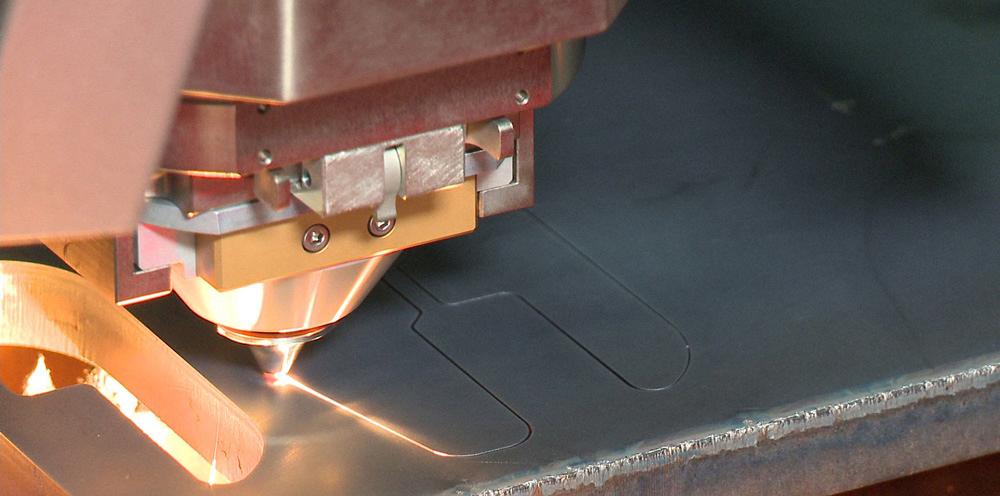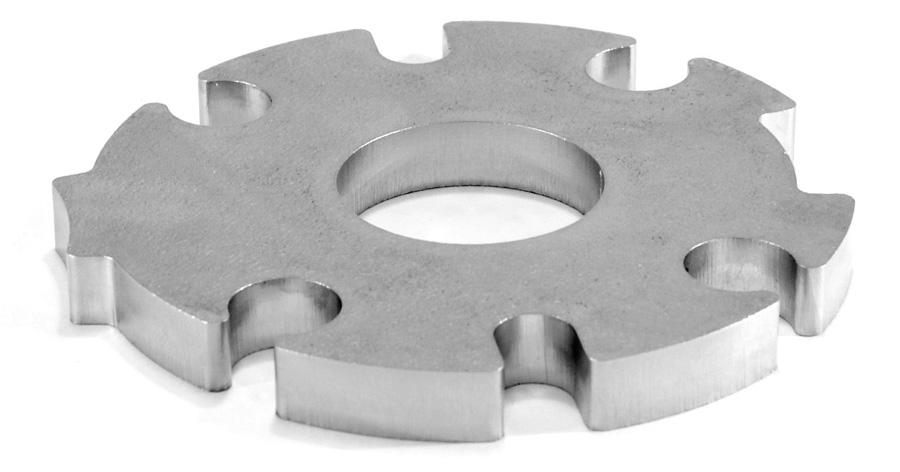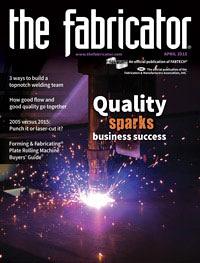- FMA
- The Fabricator
- FABTECH
- Canadian Metalworking
Categories
- Additive Manufacturing
- Aluminum Welding
- Arc Welding
- Assembly and Joining
- Automation and Robotics
- Bending and Forming
- Consumables
- Cutting and Weld Prep
- Electric Vehicles
- En Español
- Finishing
- Hydroforming
- Laser Cutting
- Laser Welding
- Machining
- Manufacturing Software
- Materials Handling
- Metals/Materials
- Oxyfuel Cutting
- Plasma Cutting
- Power Tools
- Punching and Other Holemaking
- Roll Forming
- Safety
- Sawing
- Shearing
- Shop Management
- Testing and Measuring
- Tube and Pipe Fabrication
- Tube and Pipe Production
- Waterjet Cutting
Industry Directory
Webcasts
Podcasts
FAB 40
Advertise
Subscribe
Account Login
Search
4 ways to a better laser-cut edge
Better beams, nozzles, process control, and material keep the work flowing
- April 2, 2015
- Article
- Laser Cutting

Figure 1
Advances in control systems, process monitoring, and beam quality have improved cut edges even in extremely thick material.
Lasers have become the true workhorse of metal fabrication, and they have never been more productive. They cut nests at unprecedented speeds, which has made material handling automation even more important. All the high cutting speed in the world may not dramatically affect overall cycle time if a laser sits idle for prolonged periods, waiting for operators to load sheets and unload parts.
Similar thinking also applies to edge quality. Edge quality is, of course, subjective. A machinist will look at a laser-cut part and find that the edge quality is not very good. A welder, on the other hand, may look at the same part and see a smooth, consistent, high-quality edge. Regardless, the application requirements dictate what is considered a “quality” edge. A laser can finish a nest of parts in no time flat, but what if those parts need to be sent through a secondary deburring operation?
Cutting at so many inches per minute is great, but overall cycle time may not change much if parts get caught in a deburring bottleneck. To ensure a better cut edge, operators historically had to alter cut program parameters, such as the cut speed around sharp corners, but they sometimes found that this took longer than simply sending the entire run through a deburring system.
A lot has changed since the late 1990s and early 2000s. Cutting lasers have evolved to the point where, in many cases, even thick parts emerging from the cutting bed can skip secondary deburring operations—no manual tweaking of cutting parameters required. These improvements have come mainly from advancements in four areas: material quality, nozzle technology, process control, and beam quality (see Figures 1 and 2).
1. Better Material
Within the past 15 years, higher-power lasers have allowed fabricators to cut thicker material, but the edge quality sometimes suffered. Early on it was difficult to get thick material with a smooth, mill-scale surface and consistent composition that would allow the laser to cut a consistently smooth edge.
Steel manufacturers saw the increase in demand and began to produce more laser-grade material for fabricators. Today a laser-quality, mill-scale material is readily available for companies processing 0.5 inch and even thicker steel.
2. Better Nozzles
The ability of high-powered laser machines to cut thicker materials forced cutting nozzles to advance as well. Advancements included coaxial flow nozzles for cutting steel with oxygen. When cutting with oxygen, the flow of the assist gas is very low—0.5 to 2.0 cubic feet per minute (CFM). Coaxial, or double, nozzles allowed a smooth and consistent flow of gas into the cut, producing good edge quality in steel 0.5 to 1.25 in. thick.
This technology didn’t stop with oxygen cutting. Nitrogen assist gas cutting became more popular because of the high-powered laser’s ability to cut at high speeds in thin materials. Nitrogen cutting left an oxide-free edge that was ready to be welded or painted.
Nitrogen’s downside was that it required a very high flow of gas to cut the material, so it needed a large-diameter nozzle and a high-pressure nitrogen supply to cut at higher speeds and in thicker materials. To address this, nozzle advances helped create optimal flow dynamics. Angles of the cone inside the nozzle created coaxial flow for high-pressure cutting with the least amount of turbulence within the cutting area itself. This R&D played a huge role in allowing lasers to cut parts using nitrogen, leaving them dross-free and with a consistent and smooth edge.
3. Better Process Control
As lasers grew more powerful and began cutting thicker materials, it became more difficult to achieve a dross-free part with good edge quality. Laser cutting machine OEMs saw this and started to make controllers do more than just run a program; they made processing easier and more reliable without needing a seasoned operator.

Figure 2
Today’s lasers can cut a variety of thicknesses in many materials and achieve an extremely good edge quality, smooth and consistent enough so that it need not be sent through a secondary deburring operation.
High-powered lasers were able to cut thin materials at high speed using nitrogen as an assist gas, leaving an oxide-free edge. Early on, however, some of these parts still needed a secondary operation to remove little bits of dross left on sharp corners when—still at high power—the laser slowed down to turn. To eliminate the secondary deburring, programmers would have to do a condition change to use a lower power, duty, and frequency on each corner. This took a lot of time on the programming side, and so they soon realized it was more efficient to clean up the edges after cutting rather than spend that time on programming.
Today’s controllers automate all this. They calculate the amount of power, duty, and frequency to ramp down based on the speed at which the head is traveling into a corner, and ramp up as it accelerates out of the corner. Doing this avoids overheating and prevents the dross beads from forming in the corners (see Figure 3).
Still, a laser can’t attain good edge quality without a good pierce. Older machines ran off a programmed pierce time. If the pierce did not penetrate the material in the programmed amount of time, the machine started cutting anyway, only to produce bad and probably unusable parts. So operators set excessively long pierce times to ensure the pierce penetrated completely. This added many seconds to each pierce, which prolonged the overall cycle time for a run.
In older systems, the actual cutting also ran by the set program that couldn’t adapt to unforeseen changes in the cutting conditions. If the run produced bad parts, operators still found themselves scrapping work with poor edges and cutting extra parts.
This is where process monitoring has helped fill a need. Using light sensors built into the machine, controllers now monitor the laser cut in real time. Process monitoring enables the machine to “watch” the piercing and cutting, and make adjustments so it can continue to process usable parts. With pierce monitoring, the controller watches the pierce, senses when it is through the material, and only then starts cutting parts.
Process monitoring also includes burn and plasma detection. Used when cutting steel with oxygen, burn detection watches for the cut to overheat and exhibit “oxygen runaway,” when the material burns in the kerf uncontrollably, resulting in poor edge quality. The controller sees this and makes the necessary adjustments to cool the cut slightly, temporarily decreasing power and slowing down before continuing on at a higher speed.
Similar to burn detection, plasma detection is used with nitrogen cutting. When cutting stainless steel or carbon steel with nitrogen, the laser melts the steel and the nitrogen assist gas evacuates the molten material, leaving an oxide-free edge. However, if the laser cuts too fast, turns a sharp corner, or its focus is a little off, you risk “losing the cut” and producing unusable parts.
When this happens, nitrogen and molten material create a plasma. The plasma detection sees this frequency of light and calculates that the cut will soon be lost. At this point, the machine slows the feed rate for a specified distance before ramping back up without losing the cut. The result: The system continues producing good parts with clean edges.
4. New Lasers, New Beam Parameters
OEMs have spent millions in R&D to improve laser beam quality. By producing a better beam, the laser can cut steel, stainless, and aluminum more consistently and with better edge quality. Over the decades, much of this work has focused on CO2 lasers, but in recent years R&D has also pushed the cutting envelope for solid-state lasers, including the fiber laser and, most recently, direct-diode technology.
The CO2 laser changed the course of metal fabrication. It has gotten us where we are today. The fiber laser has proven itself to be the next generation of laser cutting for the industry. With its lower maintenance cost, simplicity of operation, and capability to cut at much higher speeds than the CO2 laser, the fiber laser is the fastest-growing option for many new laser purchases. It produces edges in thin materials very similar to the high-quality edges the CO2 laser produces; but as the material thickness increases, the edge quality decreases.

Figure 3
Controllers use process monitoring to detect piercing and cutting characteristics in real time. They make the necessary changes to provide the best edge quality, even around sharp corners.
Better beams, nozzles,
process control, and material
keep the work flowing
April15FAB_
The laser beam’s quality is measured by the beam parameter product, or BPP. CO2 lasers generally have a BPP of 8 to 9 mm • mrad, which allows the laser to cut steel, stainless, and aluminum with very good edge quality. Fiber lasers generally have a BPP of 1 to 3 mm • mrad, which allows the laser to cut very fast in thinner materials—yet the edge quality in the thicker materials deteriorates. This is why the CO2 laser has been the choice of fabricators that process thicker materials.
New technology is emerging, however, that changes the beam properties of the fiber laser, allowing it to cut thick mild steel with the same quality as CO2, yet with half the wattage. This will allow fabricators to purchase a fiber laser to process their full range of material types and thicknesses, without special optics and without a lens change.
The ability to emulate CO2 edge quality on fiber machines has been, and continues to be, accomplished by use of special lenses and mirrors that change the kerf width, allowing more assist gas to enter the cut and lower the spot density. However, by changing the BPP value, the fiber laser can attain a CO2 laser’s beam quality, with the proper beam setting and without the need for additional setups and consumables.
Looking into the future, emerging technology no doubt will add another wrinkle to the laser cutting market. Several manufacturers have developed solid-state systems known as direct-diode lasers, which offer additional efficiencies and unique processing advantages. While it is still unclear how this technology will affect the current laser options, it already has shown the ability to produce excellent edge quality.
Laser technology is forever changing. Faster, more efficient systems continue to emerge—and there is still more to come.
Related Companies
subscribe now

The Fabricator is North America's leading magazine for the metal forming and fabricating industry. The magazine delivers the news, technical articles, and case histories that enable fabricators to do their jobs more efficiently. The Fabricator has served the industry since 1970.
start your free subscription- Stay connected from anywhere

Easily access valuable industry resources now with full access to the digital edition of The Fabricator.

Easily access valuable industry resources now with full access to the digital edition of The Welder.

Easily access valuable industry resources now with full access to the digital edition of The Tube and Pipe Journal.
- Podcasting
- Podcast:
- The Fabricator Podcast
- Published:
- 04/16/2024
- Running Time:
- 63:29
In this episode of The Fabricator Podcast, Caleb Chamberlain, co-founder and CEO of OSH Cut, discusses his company’s...
- Industry Events
16th Annual Safety Conference
- April 30 - May 1, 2024
- Elgin,
Pipe and Tube Conference
- May 21 - 22, 2024
- Omaha, NE
World-Class Roll Forming Workshop
- June 5 - 6, 2024
- Louisville, KY
Advanced Laser Application Workshop
- June 25 - 27, 2024
- Novi, MI































